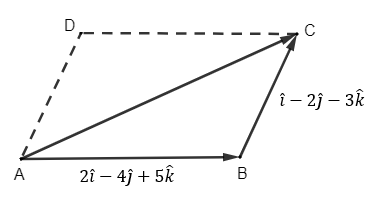The two adjacent sides of a parallelogram are ![]() and
and ![]() Find the unit vector parallel to one of its diagonals. Also, find its area.
Find the unit vector parallel to one of its diagonals. Also, find its area.
Let ABCD be a parallelogram with sides AB and AC given.
We have![]() and
and![]()

We need to find unit vector parallel to diagonal![]() .
.
From the triangle law of vector addition, we have
![]()
![]()
![]()
![]()
Let the unit vector in the direction of![]() be
be![]() .
.
We know unit vector in the direction of a vector ![]() is given by
is given by ![]() .
.

Recall the magnitude of the vector ![]() is
is
![]()
Now, we find![]() .
.
![]()
![]()
![]()
So, we have![]()
![]()
Thus, the required unit vector that is parallel to diaonal![]() is
is![]() .
.
Now, we have to find the area of parallelogram ABCD.
Recall the area of the parallelogram whose adjacent sides are given by the two vectors ![]() and
and ![]() is
is ![]() where
where

Here, we have (a1, a2, a3) = (2, –4, 5) and (b1, b2, b3) = (1, –2, –3)

![]()
![]()
![]()
Recall the magnitude of the vector ![]() is
is
![]()
Now, we find![]() .
.
![]()
![]()
![]()
Thus, area of the parallelogram is ![]() square units.
square units.